光的干涉衍射和偏振bili
光的干涉衍射与偏振

光的干涉衍射与偏振光是一种电磁波,具有波粒二象性。
在传播过程中,光可以发生干涉、衍射和偏振等现象。
本文将就光的干涉衍射与偏振进行探讨,并介绍相关实验和应用。
一、光的干涉1. 干涉现象光的干涉是指两束或多束光波相互叠加产生明暗条纹的现象。
当两束光波相遇时,根据相位差的不同,会出现增强或相消干涉。
光的干涉分为相干光的干涉和非相干光的干涉两种情况。
2. 干涉实验常见的干涉实验有杨氏双缝干涉实验、牛顿环实验等。
其中,杨氏双缝干涉实验通过用一块光栅,或者两条狭缝让光通过后形成干涉条纹,可以直观地观察到干涉的现象。
3. 透明薄膜的干涉透明薄膜的干涉是指光在两个介质交界处发生反射和透射时,由于反射光和透射光路径不同而发生干涉。
常见的例子是油膜的彩色条纹和肥皂泡的彩色环。
二、光的衍射1. 衍射现象光的衍射是指光通过一个孔或经过一个缝隙时,光波传播方向发生偏折的现象。
这是由于光的波动性质造成的。
2. 衍射实验常见的衍射实验有单缝衍射实验、双缝衍射实验等。
其中,双缝衍射实验可以通过两个狭缝让光通过后形成干涉条纹,观察到光的衍射现象。
3. 单缝衍射和多缝衍射单缝衍射和多缝衍射是光的衍射的两种基本情况。
单缝衍射下,光波经过一个狭缝后形成的衍射图样是一组等距的亮暗条纹。
多缝衍射下,光波经过多个狭缝后形成的衍射图样有更加复杂的亮暗条纹。
三、光的偏振1. 偏振现象光的偏振是指光波中的振动方向具有选择性的现象。
一束未偏振的光中的光波振动方向是各种方向都有的,而偏振后的光则只在特定方向上振动。
2. 偏振实验常见的偏振实验有偏振器实验、马吕斯定律实验等。
其中,偏振器实验可以通过使用偏振片来实现光的偏振,并通过观察光的传播方向和强度的变化来研究偏振现象。
3. 产生和应用偏振光偏振光可以通过偏振片、波片等光学元件产生。
偏振光在日常生活中有许多应用,比如3D电影中的立体效果、太阳眼镜中的消除光线反射等。
综上所述,光的干涉衍射与偏振是光的波动特性的重要表现。
高考物理考点55光的干涉光的衍射和光的偏振

高考物理2009-20XX年全国高考考题精选解析考点55 光的干涉、光的衍射和光的偏振【考点知识方法解读】光的双缝干涉:若屏上某处到双缝的光程差等于波长的整数倍,则该处出现明条纹,光程差等于半波长的奇数倍,则该处出现暗条纹。
相邻明(暗)条纹间距△x=Lλ/d。
薄膜干涉的相干光来自于薄膜的前后表面反射回来的光。
发生明显衍射现象的条件是:障碍物或小孔的尺寸比光的波长小或相差不多。
干涉和衍射都是波特有的现象。
光的偏振现象证明光是横波。
【最新三年高考物理精选解析】1.(2012·上海物理)下图为红光或紫光通过双缝或单缝所呈现的图样,则()(A)甲为紫光的干涉图样(B)乙为紫光的干涉图样(C)丙为红光的干涉图样(D)丁为红光的干涉图样2.(2012·江苏物理)如题12B-1 图所示,白炽灯的右侧依次平行放置偏振片P 和Q,A 点位于P、Q 之间,B点位于Q 右侧. 旋转偏振片P, A、B 两点光的强度变化情况是________ .(A) A、B 均不变(B) A、B 均有变化(C) A 不变,B 有变化(D) A 有变化,B 不变2.【答案】C【解析】白炽灯光是自然光,旋转偏振片P, A点光的强度不变,B 点光的强度变化,现象C正确。
【考点定位】此题考查光的偏振实验。
3.(2012·四川理综)a、b两种单色光组成的光束从介质进入空气时,其折射光束如图所示。
用a、b两束光A.先后照射双缝干涉实验装置,在缝后屏上都能出现干涉条纹,由此确定光是横波B.先后照射某金属,a光照射时恰能逸出光电子,b光照射时也能逸出光电子C.从同一介质以相同方向射向空气,其界面为平面,若b光不能进入空气,则a光也不能进入空气D.从同一介质以相同方向射向空气,其界面为平面,a光的反射角比b光的反射角大4.(2012·天津理综)半圆形玻璃砖横截面如图,AB为直径,O为圆心。
在该截面内有a、b 两束单色可见光从空气垂直于AB射入玻璃砖,两入射点到O的距离相等。
课件6:12.4 光的干涉、衍射和偏振

题型二 用双缝干涉测光的波长
【例 2】 现有毛玻璃屏 A、双缝 B、白光光源 C、单缝 D 和透红光的滤光片 E 等光学元件,要把它们放在如图 13-2-9 所示的光具座上组装成双缝干涉装置,用以测量红光的波长.
图 13-2-9
(1)将白光光源 C 放在光具座最左端,依次放置其他光学 元件,由左至右,表示各光学元件的字母排列顺序应为 C、 __________、A.
三、光的偏振 1.偏振 横波只沿某一特定的方向振动,称为波的偏振. 2.自然光 在与光波传播方向垂直的平面内光振动(指 E 的振动) 沿各个方向 振动强度 都相同.如由太阳、电灯等普通 光源发出的光.
3.偏振光 在与光波传播方向垂直的平面内只有沿着某一个 稳定方向 振动的光.如自然光经偏振片作用后的光. 4.应用 利用偏振片摄影、观看立体电影等.
(2)手轮的读数为(0.5 mm+20.0×0.01 mm)=0.700 mm. (3)条纹与分划板中心刻线不平行时,实际值 Δx 实=Δx 测 cosθ,θ 为条纹与分划板中心刻线间的夹角,故 Δx 实<Δx 测.
答案:(1)AD (2)0.700 (3)大于
教师备选 2-1 在利用双缝干涉测定光波波长时,首先 调节光源、滤光片、单缝和双缝的中心均位于遮光筒的中心轴 线上,并使单缝和双缝竖直并且互相平行,当屏上出现了干涉 图样后,用测量头上的游标卡尺去测量,转动手轮,移动分划 板使分划板中心刻线与某条明纹中心对齐时,如图 13-2-13 甲所示,将此明纹记为 1,然后再转动手轮,分划板中心刻线 向右移动,依次经过 2,3……明纹,最终与明纹 6 中心对齐, 分划板中心刻线与明纹 1 和明纹 6 对齐时游标卡尺示数分别如 图 13-2-13 中乙、丙所示
高考物理一轮复习专题53光的干涉、衍射和偏振现象含解析
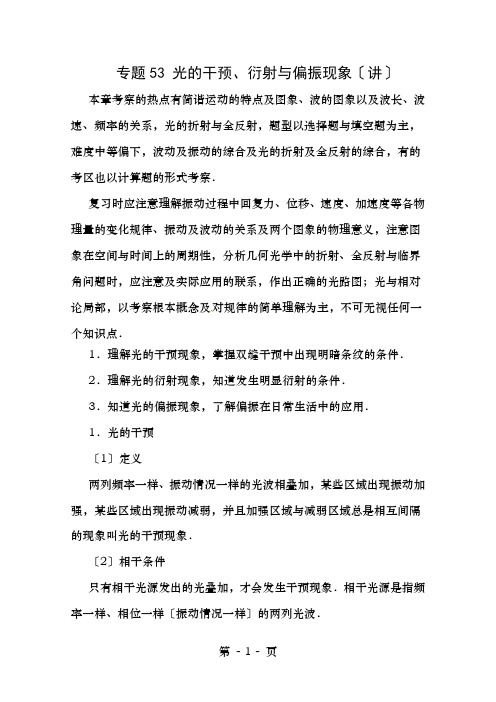
专题53 光的干预、衍射与偏振现象〔讲〕本章考察的热点有简谐运动的特点及图象、波的图象以及波长、波速、频率的关系,光的折射与全反射,题型以选择题与填空题为主,难度中等偏下,波动及振动的综合及光的折射及全反射的综合,有的考区也以计算题的形式考察.复习时应注意理解振动过程中回复力、位移、速度、加速度等各物理量的变化规律、振动及波动的关系及两个图象的物理意义,注意图象在空间与时间上的周期性,分析几何光学中的折射、全反射与临界角问题时,应注意及实际应用的联系,作出正确的光路图;光与相对论局部,以考察根本概念及对规律的简单理解为主,不可无视任何一个知识点.1.理解光的干预现象,掌握双缝干预中出现明暗条纹的条件.2.理解光的衍射现象,知道发生明显衍射的条件.3.知道光的偏振现象,了解偏振在日常生活中的应用.1.光的干预〔1〕定义两列频率一样、振动情况一样的光波相叠加,某些区域出现振动加强,某些区域出现振动减弱,并且加强区域与减弱区域总是相互间隔的现象叫光的干预现象.〔2〕相干条件只有相干光源发出的光叠加,才会发生干预现象.相干光源是指频率一样、相位一样〔振动情况一样〕的两列光波.2.双缝干预:由同一光源发出的光经双缝后,在屏上出现明暗相间的条纹.白光的双缝干预的条纹是中央为白色条纹,两边为彩色条纹,单色光的双缝干预中相邻亮条纹间距离为.3.薄膜干预:利用薄膜〔如肥皂液薄膜〕前后两面反射的光相遇而形成的.图样中同一条亮〔或暗〕条纹上所对应的薄膜厚度一样.4.光的衍射〔1〕定义光离开直线路径绕到障碍物阴影区的现象叫光的衍射,衍射产生的明暗条纹或光环叫衍射图样.〔2〕发生明显衍射的条件只有当障碍物的尺寸跟光的波长相差不多,甚至比光的波长还小的时候,衍射现象才会明显.〔3〕衍射图样①单缝衍射a.单色光:明暗相间的不等距条纹,中央亮纹最宽最亮,两侧条纹具有对称性.b.白光:中间为宽且亮的白色条纹,两侧是窄且暗的彩色条纹,最靠近中央的是紫光,远离中央的是红光.②圆孔衍射:明暗相间的不等距圆环,圆环面积远远超过孔的直线照明的面积.③圆盘衍射:明暗相间的不等距圆环,中心有一亮斑称为泊松亮斑.5.光的偏振〔1〕偏振:光波只沿某一特定的方向振动,称为光的偏振.〔2〕自然光:太阳、电灯等普通光源发出的光,包含着在垂直于传播方向上沿一切方向振动的光,而且沿各个方向振动的光波的强度都一样,这种光叫做自然光.〔3〕偏振光:在垂直于传播方向的平面上,只沿某个特定方向振动的光,叫做偏振光.光的偏振证明光是横波.自然光通过偏振片后,就得到了偏振光.考点一光的干预现象的理解1、光的双缝干预现象的理解〔1〕光能够发生干预的条件:两光的频率一样,振动步调一样.〔2〕双缝干预形成的条纹是等间距的,两相邻亮条纹或相邻暗条纹间距离及波长成正比,即.〔3〕用白光照射双缝时,形成的干预条纹的特点:中央为白条纹,两侧为彩色条纹.2、薄膜干预现象的理解〔1〕如下图,竖直的肥皂薄膜,由于重力的作用,形成上薄下厚的楔形.〔2〕光照射到薄膜上时,在膜的前外表AA′与后外表BB′分别反射出来,形成两列频率一样的光波,并且叠加.〔3〕原理分析①单色光在P1、P2处,两个外表反射回来的两列光波的路程差Δr等于波长的整数倍.Δr=nλ〔n=1,2,3…〕,薄膜上出现明条纹.在Q处,两列反射回来的光波的路程差Δr等于半波长的奇数倍.Δr=〔2n+1〕λ2〔n=0,1,2,3…〕,薄膜上出现暗条纹.②白光:薄膜上出现水平彩色条纹.〔4〕薄膜干预的应用干预法检查平面如下图,两板之间形成一楔形空气膜,用单色光从上向下照射,如果被检平面是平整光滑的,我们会观察到平行且等间距的明暗相间的条纹;假设被检平面不平整,那么干预条纹发生弯曲.★重点归纳★1、两束振动情况一样的光源产生的光相互叠加时:〔1〕出现明条纹的条件是屏上某点P到两个相干光源S1与S2的路程差等于波长的整数倍或半波长的偶数倍,即|PS1-PS2|=kλ=2k·2λ〔k=0,1,2,3…〕当k=0时,即PS1=PS2,此时P点处的明条纹叫做中央亮条纹.〔2〕出现暗条纹的条件是屏上某点P到两个相干光源S1与S2的路程差等于半波长的奇数倍,即|PS1-PS2|=〔2k+1〕2λ〔k=0,1,2,3…〕★典型案例★如下图,两束不同的单色光P与Q射向半圆形玻璃砖,其出射光线都是从圆心O点沿O F方向,由此可知:〔〕A.Q光穿过玻璃砖所需的时间比P光短B.P光的波长比Q光的波长小C.P、Q两束光以一样的入射角从水中射向空气,假设Q光能发生全反射,那么P光也一定能能发生全反射D.如果让P、Q两束单色光分别通过同一双缝干预装置,P光形成的干预条纹间距比Q光的大【答案】D【名师点睛】解决此题的关键是通过光路图比拟出折射率的大小,要掌握折射率及光速、波长的关系,知道折射率越大,相应的光的频率越大。
光的干涉、衍射和偏振

光的干涉、衍射和偏振
1.光的干涉
(1)定义:在两列光波叠加的区域,某些区域相互加强,出现亮条纹,某些区域相互减弱,出现暗条纹,且加强区域和减弱区域相互间隔的现象.
(2)条件:两束光的频率相同、相位差恒定.
(3)双缝干涉图样特点:单色光照射时形成明暗相间的等间距的干涉条纹;白光照射时,中央为白色亮条纹,其余为彩色条纹.
2.光的衍射
发生明显衍射的条件:只有当障碍物的尺寸与光的波长相差不多,甚至比光的波长还小的时候,衍射现象才会明显.
3.光的偏振
(1)自然光:包含着在垂直于传播方向上沿一切方向振动的光,而且沿着各个方向振动的光波的强度都相同.
(2)偏振光:在垂直于光的传播方向的平面上,只沿着某个特定的方向振动的光.
(3)偏振光的形成
①让自然光通过偏振片形成偏振光.
②让自然光在两种介质的界面发生反射和折射,反射光和折射光可以成为部分偏振光或完全偏振光.
(4)光的偏振现象说明光是一种横波.
第1页共1页。
大学物理光学知识点总结(干涉衍射偏振(二)2024

大学物理光学知识点总结(干涉衍射偏振(二)引言概述:大学物理光学是研究光的基本性质和现象的学科,其中包括了干涉、衍射和偏振等重要的知识点。
在本文中,我们将对大学物理光学中的干涉、衍射和偏振知识进行总结,帮助读者更好地理解和掌握这些重要的光学概念。
正文内容:一、干涉1. 连续光波干涉的基本原理2. 杨氏双缝实验的干涉原理3. 干涉截带和干涉条纹的特性4. 干涉现象的应用——薄膜干涉5. 干涉横纹和纵纹的解释二、衍射1. 菲涅尔衍射和菲涅尔衍射积分公式2. 衍射与光波的波阵面3. 点光源和光屏上的衍射图样4. 衍射条纹的特性和衍射极限5. 衍射现象的应用——衍射光栅三、偏振1. 偏振光的概念和分类2. 偏振光的振动方式3. 偏振光的传播规律——马吕斯定律和布儒斯特定律4. 偏振器的原理和种类5. 偏振现象的应用——偏振光在光学仪器中的应用四、干涉衍射的综合应用1. 单缝衍射和双缝干涉的关系2. 由单缝衍射引出的光学仪器——楞次圆板3. 多缝衍射和光栅的关系4. 干涉衍射在人类视觉中的应用5. 干涉衍射在激光技术中的应用五、物理光学的未来发展与应用前景1. 光学计算与光学信息处理2. 纳米材料与纳米光学技术3. 超材料与超透镜技术4. 光学成像与三维显示技术5. 生物医学光学与光谱学总结:本文总结了大学物理光学中的干涉、衍射和偏振等知识点。
我们通过对干涉的原理、衍射的特性和偏振的应用等内容的详细讲解,帮助读者更好地理解和掌握这些知识。
同时,我们还介绍了干涉衍射的综合应用以及物理光学未来的发展与应用前景。
希望本文能对读者进一步学习和研究光学提供一定的帮助。
第30讲 光的干涉、衍射和偏振(解析版)

第30讲光的干涉、衍射和偏振目录考点一光的双缝干涉现象 (1)考点二薄膜干涉现象 (1)考点三光的干涉和衍射的比较 (6)考点四光的偏振现象 (9)练出高分 (13)考点一光的双缝干涉现象1.产生条件两列光的频率相同,振动方向相同,且具有恒定的相位差,才能产生稳定的干涉图样.2.杨氏双缝干涉(1)原理图如图1所示图1(2)亮、暗条纹的条件.①单色光:形成明暗相间的条纹,中央为亮条纹.a.光的路程差Δr=r2-r1=kλ(k=0,1,2…),光屏上出现亮条纹.b.光的路程差Δr=r2-r1=(2k+1)λ2(k=0,1,2…),光屏上出现暗条纹.②白光:光屏上出现彩色条纹,且中央亮条纹是白色(填写颜色).③条纹间距公式:Δx=ldλ.[例题1](2022•徐汇区三模)如图是单色光的“杨氏双缝干涉实验”,若要使干涉条纹变宽,可以()A.增大单缝到双缝之间的距离B.减小单缝到双缝之间的距离C.增大双缝到屏幕之间的距离D.减小双缝到屏幕之间的距离【解答】解:根据条纹间距公式Δx=Lλd,其表中L示双缝到屏的距离,d表示双缝之间的距离,可知若要使干涉条纹变宽,可知增大双缝到屏幕之间的距离和减小双缝之间的距离,换波长较长的光,故C正确,ABD错误。
故选:C。
[例题2](2022•天津二模)如图是a、b两光分别经过同一双缝干涉装置后在屏上形成的干涉图样,则()A.从同种介质射入真空发生全反射时,a光临界角大B.照射在同一金属板上发生光电效应时,a光的饱和电流一定大C.在同种均匀介质中,a光的传播速度比b光的大D.若两光均由氢原子能级跃迁产生,产生a光的能级能量差大【解答】解:AB、由图可知a光的干涉条纹间距小于b光,根据Δx=Ldλ可知,a的波长小于b光,则a光的频率大于b光,a的折射率大于b光,根据sinC=1n可知,同种介质射入真空发生全反射时,b光临界角大,故A错误;B、光电效应时饱和电流与入射光的强度有关,所以无法判断饱和电流的大小,故B错误;C、a的折射率大于b光,根据n=cv可知,在同种介质中传播时a光的传播速度比b光的小,故C错误;D、若两光均由氢原子能级跃迁产生,因a光的频率大,所以产生a光对应光子的能量大于b光对应光子的能量,产生a光的能级能量差大,故D正确。
高三物理光的干涉、衍射和偏振

(
)C
A.在真空中,a的波长小于b的波长
B.在真空中,a的速度大于b的速度
C.a光的频率小于b光的频率
D.若光从水射向空气,a光的临界角小于b光的临
界角
a
b
年福建省毕业班质量检查 15 15.下列说法正确的是 ( D )
A.太阳光通过三棱镜形成彩色光谱,这是光的 干涉的结果
B.用光导纤维束传送图象信息,这是光的衍射 的应用
062.北京市海淀区二模反馈题13
由光电效应产生条件可知B 正确。
13.下面是四种与光有关的事实 根据干涉条纹的间距的公式
B.增大双缝到屏的距离,干涉条纹间的距离增大
北京西城区08年4月物理一模15
①用光导纤维传播信号; D.在照相机镜头前加装偏振滤光片拍摄日落时水面下的景物,可使景像清晰
由于红光的波长大于蓝光的波长,由
r12
L2
(xd)2 2
r22
L2
(xd)2 2
S1
r1
P x
考虑到 L >>d 和 L >>x,
d
r2
O
可得 dx
S2 L
L
若光波长为λ,则当 k(k=0,1,2,…)
时,两束光叠加干涉加强;
当
(2k1)
(k=1,2,3,…)时,
两束光叠加干涉2减弱,
据此不难推算出
(1)明纹坐标
x k L
L
可得红光的条纹间距大于蓝光的条纹间距,d D正确。
年高考理综天津卷 16 16.下列有关光现象的说法正确的是 ( A )
A.在光的双缝干涉实验中,若仅将入射光由紫 光改为红光,则条纹间距一定变大
B.以相同入射角从水中射向空气,紫光能发生 全反射,红光也一定能发生全反射
高中物理选修3-4“光的干涉、衍射和偏振”知识点
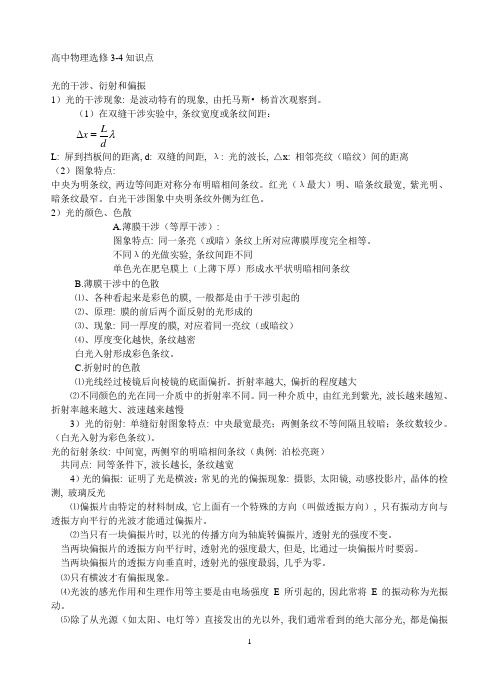
高中物理选修3-4知识点光的干涉、衍射和偏振1)光的干涉现象: 是波动特有的现象, 由托马斯•杨首次观察到。
(1)在双缝干涉实验中, 条纹宽度或条纹间距:λdL x =∆ L: 屏到挡板间的距离, d: 双缝的间距, λ: 光的波长, △x: 相邻亮纹(暗纹)间的距离(2)图象特点:中央为明条纹, 两边等间距对称分布明暗相间条纹。
红光(λ最大)明、暗条纹最宽, 紫光明、暗条纹最窄。
白光干涉图象中央明条纹外侧为红色。
2)光的颜色、色散A.薄膜干涉(等厚干涉):图象特点: 同一条亮(或暗)条纹上所对应薄膜厚度完全相等。
不同λ的光做实验, 条纹间距不同单色光在肥皂膜上(上薄下厚)形成水平状明暗相间条纹B.薄膜干涉中的色散⑴、各种看起来是彩色的膜, 一般都是由于干涉引起的⑵、原理: 膜的前后两个面反射的光形成的⑶、现象: 同一厚度的膜, 对应着同一亮纹(或暗纹)⑷、厚度变化越快, 条纹越密白光入射形成彩色条纹。
C.折射时的色散⑴光线经过棱镜后向棱镜的底面偏折。
折射率越大, 偏折的程度越大⑵不同颜色的光在同一介质中的折射率不同。
同一种介质中, 由红光到紫光, 波长越来越短、折射率越来越大、波速越来越慢3)光的衍射: 单缝衍射图象特点: 中央最宽最亮;两侧条纹不等间隔且较暗;条纹数较少。
(白光入射为彩色条纹)。
光的衍射条纹: 中间宽, 两侧窄的明暗相间条纹(典例: 泊松亮斑)共同点: 同等条件下, 波长越长, 条纹越宽4)光的偏振: 证明了光是横波;常见的光的偏振现象: 摄影, 太阳镜, 动感投影片, 晶体的检测, 玻璃反光⑴偏振片由特定的材料制成, 它上面有一个特殊的方向(叫做透振方向), 只有振动方向与透振方向平行的光波才能通过偏振片。
⑵当只有一块偏振片时, 以光的传播方向为轴旋转偏振片, 透射光的强度不变。
当两块偏振片的透振方向平行时, 透射光的强度最大, 但是, 比通过一块偏振片时要弱。
当两块偏振片的透振方向垂直时, 透射光的强度最弱, 几乎为零。
物理光学干涉衍射与偏振问题
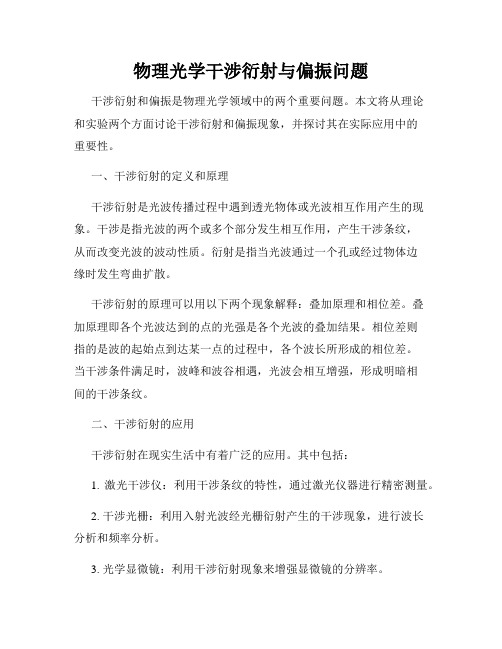
物理光学干涉衍射与偏振问题干涉衍射和偏振是物理光学领域中的两个重要问题。
本文将从理论和实验两个方面讨论干涉衍射和偏振现象,并探讨其在实际应用中的重要性。
一、干涉衍射的定义和原理干涉衍射是光波传播过程中遇到透光物体或光波相互作用产生的现象。
干涉是指光波的两个或多个部分发生相互作用,产生干涉条纹,从而改变光波的波动性质。
衍射是指当光波通过一个孔或经过物体边缘时发生弯曲扩散。
干涉衍射的原理可以用以下两个现象解释:叠加原理和相位差。
叠加原理即各个光波达到的点的光强是各个光波的叠加结果。
相位差则指的是波的起始点到达某一点的过程中,各个波长所形成的相位差。
当干涉条件满足时,波峰和波谷相遇,光波会相互增强,形成明暗相间的干涉条纹。
二、干涉衍射的应用干涉衍射在现实生活中有着广泛的应用。
其中包括:1. 激光干涉仪:利用干涉条纹的特性,通过激光仪器进行精密测量。
2. 干涉光栅:利用入射光波经光栅衍射产生的干涉现象,进行波长分析和频率分析。
3. 光学显微镜:利用干涉衍射现象来增强显微镜的分辨率。
4. 光波导技术:通过控制光的干涉来实现光信号的传输和分析。
三、偏振光的定义和原理偏振是指光波的振动方向不是在所有方向上都均匀分布的现象。
偏振光可以通过偏振器来产生,偏振器是一个光学器件,可以选择性地传递或阻挡特定方向上的光波。
偏振光的原理可以通过振动方向和波长方向的关系来解释。
光的振动方向与光波的传播方向垂直时,称为正交振动。
而偏振器只能允许振动方向与光波传播方向相同的光通过,因此只有满足偏振器方向的光可以通过,其他光会被阻挡。
四、偏振光的应用偏振光在许多领域中有着广泛的应用。
以下是几个示例:1. 光学显微镜:通过使用偏振光,可以增强显微镜的图像对比度。
2. 液晶显示器:液晶分子只能让特定方向上的光通过,所以液晶显示器可以通过改变电场来控制光的偏振方向。
3. 拍摄滤镜:摄影中使用的偏振滤镜可以减少反射和增加对比度。
4. 3D电影:通过使用偏振镜片,可以实现立体影像的效果。
关于光的干涉,衍射以及偏振的定义

关于光的干涉,衍射以及偏振的定义
光的干涉(inteference)指的是两束或多束光波相遇时产生的互相加强或减弱的现象。
当光波的相位差满足一定条件时,会出现明暗相间、条纹交替的干涉图像。
光的衍射(diffraction)指的是光波通过一个或多个障碍物的边缘或孔径时,沿着各个方向发生弯曲和扩散的现象。
衍射可在光屏上产生明暗交替的衍射图案。
光的偏振(polarization)是指光波在传播过程中的振动方向。
一般来说,光波的振动方向是随机分布的,即不具有特定的偏振方向。
然而,通过适当的装置,可以将光波的振动方向约束在特定的方向上,形成偏振光。
偏振光具有特定的偏振方向,可用偏振片等器件进行观察和操作。
干涉衍射偏振基本知识点
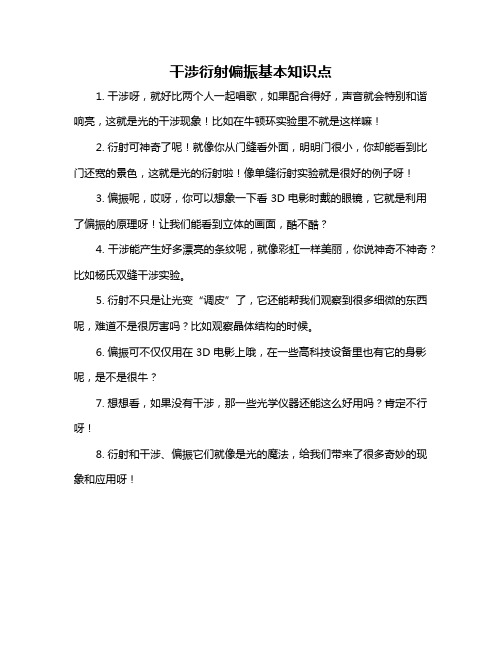
干涉衍射偏振基本知识点
1. 干涉呀,就好比两个人一起唱歌,如果配合得好,声音就会特别和谐响亮,这就是光的干涉现象!比如在牛顿环实验里不就是这样嘛!
2. 衍射可神奇了呢!就像你从门缝看外面,明明门很小,你却能看到比门还宽的景色,这就是光的衍射啦!像单缝衍射实验就是很好的例子呀!
3. 偏振呢,哎呀,你可以想象一下看 3D 电影时戴的眼镜,它就是利用了偏振的原理呀!让我们能看到立体的画面,酷不酷?
4. 干涉能产生好多漂亮的条纹呢,就像彩虹一样美丽,你说神奇不神奇?比如杨氏双缝干涉实验。
5. 衍射不只是让光变“调皮”了,它还能帮我们观察到很多细微的东西呢,难道不是很厉害吗?比如观察晶体结构的时候。
6. 偏振可不仅仅用在 3D 电影上哦,在一些高科技设备里也有它的身影呢,是不是很牛?
7. 想想看,如果没有干涉,那一些光学仪器还能这么好用吗?肯定不行呀!
8. 衍射和干涉、偏振它们就像是光的魔法,给我们带来了很多奇妙的现象和应用呀!
我的观点结论是:干涉、衍射、偏振这些基本知识点真的太重要且有趣了,它们让我们对光有了更深入的认识和理解,也为我们的生活带来了很多惊喜和便利。
机械振动机械波光电磁波相对论第4讲光的波动性电

D.将绿光换为紫光,干涉条纹间的距离增大
解析 由双缝干涉条纹间距公式 Δx=Ldλ 可知,减小双缝间的 距离 d,干涉条纹间的距离 Δx 增大,A 错误;增大双缝到屏 的距离 L,干涉条纹间的距离增大,B 正确;将绿光换为红光, 入射光的波长增大,干涉条纹间的距离应增大,C 错误;将绿 光换为紫光,入射光的波长变短,干涉条纹间的距离应减小, D 错误.
同,即 v=nc;故 A 正确、B 错误;电磁波和机械波都能产生干
涉和衍射现象,故 C 错、D 正确.
答案 AD
5.光的偏振现象说明光是横波.下列现象中不能反映光的偏 振特性的是 ( ). A.一束自然光相继通过两个偏振片,以光束为轴旋转其 中一个偏振片,透射光的强度发生变化 B.一束自然光入射到两种介质的分界面上,当反射光线 与折射光线之间的夹角恰好是90°时,反射光是偏 振光 C.日落时分,拍摄水面下的景物,在照相机镜头前装上偏 振滤光片可以使景象更清晰 D.通过手指间的缝隙观察日光灯,可以看到彩色条纹 解析 由光的偏振现象的知识可知A、B、C均反映了光的偏 振特性,只有D选项是利用手指间的狭缝去观察光的衍射现 象,故选D.
7.下面列出一些医疗器械的名称和这些器械运用的物理现 象.请将相应的字母填写在运用这种现象的医疗器械后面 的空格上. (1)X光机,________. (2)紫外线灯,________. (3)理疗医用“神灯”照射伤口,可使伤口愈合得较好.这 里的“神灯”是利用________. A.光的全反射 B.紫外线具有很强的荧光作用 C.紫外线具有杀菌消毒作用 D.X射线的很强的贯穿力 E.红外线具有显著的热效应 F.红外线波长较长,易发生衍射
图1-4-6
①在B板上方观察到的亮暗变化是由哪两个表面的反射光叠 加形成的? ②温度由t1升高到t2时,A的高度升高多少? (2)①肥皂泡在太阳光照射下呈现的彩色是________现 象;露珠在太阳光照射下呈现的彩色是________现象;通 过狭缝看太阳光时呈现的彩色是________现象. ②凡是波都具有衍射现象,而把光看做直线传播的条件是 ________.要使光产生明显的衍射,条件是 ____________
选修3-4 第4讲 光的干涉、衍射和偏振 电磁波与相对论
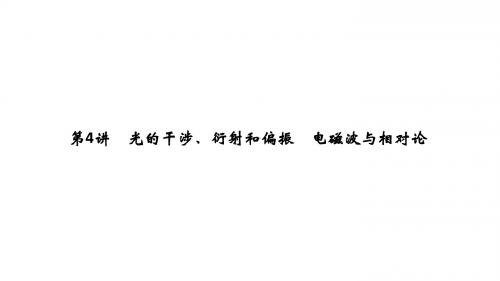
解析 光学镜头上的增透膜是利用光的干涉现象,减弱反射光的强度,增加透射 光的强度,A 正确;用三棱镜观察白光看到的彩色图样是利用光的色散现象,B 错误;在光导纤维束内传送图象是利用光的全反射现象,C 正确;用透明的标准 平面样板检查光学平面的平整程度是利用光的干涉现象,D 错误;根据公式 Δx =ldλ可得红光变成绿光,波长变小,故干涉条纹间距变窄,E 正确。
4.如图1所示,A、B两幅图是由同一束单色光分别入射到圆孔而形成的图样,其中图 A是光的__________(选填“干涉”或“衍射”)图样。由此可以判断出图A所对应的 圆孔的孔径__________(选填“大于”或“小于”)图B所对应的圆孔的孔径。
图1 答案 衍射 小于
1.光的干涉、衍射比较 内容
解析 对于同一障碍物,它的尺寸d不变,波长λ越长的光越容易满足d≤λ,越容易 绕过障碍物,所以A项正确;白光通过三棱镜出现彩色条纹是光的色散现象,B项 错误;波的频率由波源决定,波速由介质决定,所以红光从空气进入水中,频率f 不变,波速v变小,由v=λf得,波长λ变小,所以C项错误;检查平面的平整度是利 用了光的干涉,所以D项正确;由光速不变原理知E项正确。 答案 ADE
第4讲 光的干涉、衍射和偏振 电磁波与相对论
知识排查
光的干涉 1.定义:在两列光波叠加的区域,某些区域相互加强,出现__亮____条纹,某些区域相
互减弱,出现_暗____条纹,且加强区域和减弱区域相互间隔的现象。 2.条件:两束光的频率___相__同__、相位差恒定。
3.双缝干涉图样特点 (1) 单 色 光 照 射 时 形 成 明 暗 相 间 的 等 间 距 的 干 涉 条 纹 ; 白 光 照 射 时 , 中 央 为 _白__色__亮___条纹,其余为__彩__色____条纹。
- 1、下载文档前请自行甄别文档内容的完整性,平台不提供额外的编辑、内容补充、找答案等附加服务。
- 2、"仅部分预览"的文档,不可在线预览部分如存在完整性等问题,可反馈申请退款(可完整预览的文档不适用该条件!)。
- 3、如文档侵犯您的权益,请联系客服反馈,我们会尽快为您处理(人工客服工作时间:9:00-18:30)。
光的干涉衍射和偏振bili
英文回答:
Interference and diffraction are two important phenomena in the study of light. These phenomena occur when light waves interact with each other or with obstacles in their path.
Interference refers to the superposition of two or more coherent light waves. When two light waves of the same frequency and phase meet, they can either reinforce each other (constructive interference) or cancel each other out (destructive interference). This can result in the formation of bright and dark fringes, known as interference patterns. Interference is commonly observed in experiments with double slits or thin films.
Diffraction, on the other hand, occurs when light waves encounter an obstacle or aperture that is comparable in size to the wavelength of light. The waves bend or spread
out as they pass through the opening, resulting in the bending of light around corners or the spreading out of light waves. This leads to the formation of patterns, such as the single-slit diffraction pattern or the circular pattern observed when light passes through a small hole.
Polarization is another property of light that can be observed and manipulated. Polarization refers to the orientation of the electric field vector of a light wave. Light waves can be polarized in different directions, such as vertically, horizontally, or at an angle. Polarization can be achieved through various methods, such as using polarizing filters or reflection.
Now, let's switch to Chinese and continue the explanation.
中文回答:
光的干涉和衍射是光学研究中两个重要的现象。
这些现象发生在光波相互作用或与光路中的障碍物相互作用时。
干涉是指两个或更多相干光波的叠加。
当两个具有相同频率和
相位的光波相遇时,它们可以相互加强(构造干涉)或相互抵消
(破坏干涉)。
这会导致明暗条纹的形成,称为干涉图案。
在双缝
或薄膜实验中常常观察到干涉现象。
而衍射则是当光波遇到与光波波长相当的障碍物或孔径时发生
的现象。
光波在通过孔径时会弯曲或扩散,导致光绕过障碍物或光
波扩散。
这会导致形成各种图案,例如单缝衍射图案或光通过小孔
时观察到的圆形图案。
偏振是光的另一个可以观察和操控的性质。
偏振是指光波的电
场矢量的方向。
光波可以以不同的方向偏振,例如垂直方向、水平
方向或角度方向。
可以通过使用偏振滤波器或反射等方法实现光的
偏振。
To illustrate these concepts, let's consider an example. Imagine you have two identical light sources emitting light waves of the same frequency and phase. If you place a
screen with two small slits in front of the light sources, you will observe an interference pattern on a second screen placed behind the slits. This pattern consists of
alternating bright and dark fringes. This is an example of
interference, where the light waves from the two slits interfere with each other, resulting in the formation of
the interference pattern.
Now, let's consider diffraction. If you shine a laser beam through a narrow slit, you will observe a diffraction pattern on a screen placed behind the slit. This pattern consists of a central bright spot surrounded by a series of concentric rings. This is an example of diffraction, where the light waves spread out after passing through the narrow slit, resulting in the formation of the diffraction pattern.
In terms of polarization, let's consider an example of polarized sunglasses. When light from the sun reflects off
a flat surface, it becomes polarized in a specific direction. This polarized light can cause glare and discomfort to our eyes. However, if we wear polarized sunglasses, they can selectively block the horizontally polarized light, reducing the glare and allowing us to see more comfortably. This is an example of how polarization
can be used to control the transmission of light and
improve visual clarity.
In conclusion, interference and diffraction are phenomena that occur when light waves interact with each other or with obstacles in their path. Polarization, on the other hand, refers to the orientation of the electric field vector of a light wave. These concepts are important in understanding the behavior of light and have practical applications in various fields, such as optics, photography, and telecommunications.
总结一下,干涉和衍射是光波相互作用或与障碍物相互作用时
发生的现象。
偏振则是光波电场矢量的方向。
这些概念对于理解光
的行为非常重要,并在光学、摄影和通信等各个领域有着实际应用。
